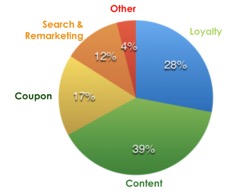After 20 years of affiliate revenue being dominated by the coupon and loyalty space, we are now on the verge of a shift where content creators are becoming a powerful force within the performance marketing space.
“Influencers” and content creators of various types are learning the benefits of affiliate marketing as a monetisation strategy and engaging more frequently in performance-based-marketing initiatives.
This is an exciting development within our industry as the ability to track and now reach, engage, and convert new groups of buyers with content partnerships is on the rise.
But before we get into it, let’s define the difference between a content creator and an influencer.
What is a content creator?
A content creator is any person or company that creates content to educate, inform or entice their audience, shared through a variety of distribution channels, and usually on their own website, blog, newsletter, YouTube Channel, or social channel. This can be accomplished through a variety of media such as articles, videos, podcasts, visual graphics or photography.
Content creators may or may not have an existing audience, but they are usually focused on creating content on a particular topic or niche with a particular audience in mind. That is why content creators are in high demand online, because they can speak to an audience and impact their buying behaviours often times more successfully than a brand itself, including other paid marketing channels.
What is an Influencer?
There are many definitions of an influencer, and the minimum number of followers people use to define an “Influencer” is subjective. So to keep it simple, I will use the definition from Dictionsary.com, which sums it up nicely: “An Influencer is a person who has the power to influence many people, as through social media or traditional media: Companies look for Facebook influencers who can promote their brand.”
In other words, an Influencer is someone who affects or changes the way that other people behave based on their influence over them.
To clarify, a content creator can be an influencer, and an influencer can be a content creator, but not all content creators are influencers.
Can you show me some examples so I’m crystal clear?
Sure! Since this article is about whether content creators are becoming affiliates or not, let me give you some examples of the types of content affiliates that companies work with today.
Lifestyle sites
Lifestyle sites, which usually come in the form of personal blogs or community sites, is a fantastic place to start. There are so many of them, on every topic your heart could desire, and people have become fabulous at creating beautiful, engaging content pieces that their readers love and share with others. These types of sites are especially good at introducing products, giving advice on how to use them and moving people further down the funnel as they move closer to a sale.
Instagram & social influencers
These content creators are usually individuals (or a small group of people managing the same profile on a social page) who have a loyal, established fan base, strong engagement and have fun sharing their hobbies, pastimes and favourite products with their audience. They often use short descriptions with Hashtags and either shortened URLs with their affiliate links within or exclusive codes they can share (which are trackable). The examples below showcase influencers who have figured out how to do affiliate marketing right.
Cool pose + great quality image + engagement with fans + trackable short link to products in the image = Success!
Beautiful hair + product shot + description, short link and offer + engagement = Success!
Review sites
One of the best performing content sites, review sites provide a ton of information about a product or service, usually described in full detail with product images, rating, customer quotes, key learnings, and a full list of features, advantages, benefits and pricing. The example below is from The Wirecutter, now owned by the New York Times. This content affiliate drove so many sales for the brands that they worked with that they were acquired for just over $30 million dollars just a few short years ago.
Forums
Often overlooked, forums are a great way to get in front of the eyeballs of people interested in a particular subject who want to engage with other like-minded people or who are looking for feedback or answers to their questions. Forums can be found on every topic you can imagine, from video games to interior design to organic cooking to travel and more. One of the best things about forums is that the content produced here is by a variety of other people, and the content can be personal and frequent. By doing a Google search for your topic, vertical and then
“forum” or “forums” will help you find the ones that rank most highly and are likely the most engaged.
Facebook groups
Both private and public Facebook Groups create great content for their followers. Some of this content is fuelled by members of the group, while other times it’s created by the group creator or admin. Without naming names, I interviewed one affiliate who owns over 400 private Facebook groups and has over 40 full-time staff managing them, all with affiliate marketing partnerships as their main revenue source. Facebook group owners put in a lot of time and effort into growing and engaging audiences within the platform, and there is much value in the influence and contributions they make to new customer acquisition, brand awareness, product engagement and third-party endorsements.
Style guides
Many of you have heard of RewardStyle, or other private networks of influencers and content creators. The good news is you can work with these types of partners within a performance-based model, who have ample engagement with content creators, many of which create their own Style Guides and Look-Books. These Style Guides and Look-Books can work in many different categories of products, from fashion and apparel to health and beauty, home and garden design and more. You can also work with content creators directly to help them create their own Look-Books or Style Guides by using your products in the visual content of their recommendations and product grouping designs.
How-to sites
One of the most famous review and “How-To” sites is The Points Guy. The Points Guy not only keynoted Affiliate Summit West a couple of years ago but also built out his entire business leveraging affiliate marketing links as his primary revenue driver. Years later he sold his How-to site for millions of dollars and was able to enjoy a carefree life as a result. The point is, this How-to site, which focuses on how to travel the world and enjoy life by leveraging travel and lifestyle points through credit cards and loyalty programs, built up such a loyal following and fan base, that companies were scrambling to work with them to reach their engaged (and very influenced) audience. Today, they have thriving social channels including a highly engaged YouTube channel, hosting multiples of content posts per day, while leveraging affiliate links to drive the bulk of their revenue.
YouTubers
Many companies have found an influx of YouTubers turning to affiliate marketing to help monetise their sites. Maarten Heilborn, for example, has over 72,000 followers on his YouTube channel and wants to monetise it through affiliate marketing partnerships. He has the base of followers, he has the quality videos and he’s an expert in his space. Plus he understands the benefit of affiliate marketing in helping him fund his page and earn his keep. More and more YouTubers are realising the potential of their earnings through affiliate marketing partnerships, and with YouTube being the second largest search engine in the world, this is a great place to start or look to next.
Does working with content creators actually drive results?
Absolutely 100%. Both content creators and influencers can add significant value to an affiliate program if done right.
Here is a real-life partner portfolio example from one of the brands we manage. It showcases that the majority of transactions, 39% in fact, were driven by content creators, followed secondly by loyalty at 28% and thirdly by coupon partners at 17%. This debunks the belief that content creators do not do affiliate marketing, and that they are not effective at driving sales. Further, the additional contribution to top of funnel and mid-funnel contributions adds significant benefits such as brand awareness, product exposure, third-party endorsements (ambassadorship) and customer engagement that is hard to find with other types of partners in the performance marketing space.
What do I need to get started with content creators?
The trick is knowing who to recruit, how to recruit them, understanding what they need/want/will ask for, and having the proper resources and attribution set up to identify and credit the contribution they are making to your buyer’s purchase journey, including when they first get exposed to you and your brand.
Content affiliates are here to stay, and further, they are going to continue to enter the market as they realize the benefits of affiliate marketing as a passive income monetization strategy. They can continue to charge for sponsored posts again and again until they burn out or retire, or they can leverage affiliate links and commissions on sales to further their long-term earnings while doing it in their sleep.
As you get into working with this group of partners, understand that they have lots of options of things to write about, so you have to make it appealing and easy for them to get started with you.
Some steps you can take right off the bat to ensure you are ready are:
- Identify and use of high performing content & keywords from your own site in your content and communication pieces with partners.
- Integrate content partner and influencer outreach with your internal content calendar for the full year tied to corporate brand content, promotions and your product merchandising strategy.
- Distribute content through your internal database of partners and through social channel engagement. Use relevant Hashtags and keyword searches in your outreach and recruitment.
- Ensure your attribution is set up in a way that gives you full transparency into who, when, how and at which point in the buyer cycle, these content partners are contributing to the sale, and credit them accordingly.
- Have an already established database of assets these partners can use to be more successful with you. This could be pre-written content, a quick-start guide, your brand manual, your high converting keywords, your best-selling products, special offers and deals coming soon, how-to tutorials, style guides, and more.
Content creators take time and attention, and they need different things than coupon and loyalty partners. Be ready with your assets, your understanding of their needs, your strategic content ideas (to brainstorm with them) and the ability to track and measure their contributions for both of your mutual successes.












